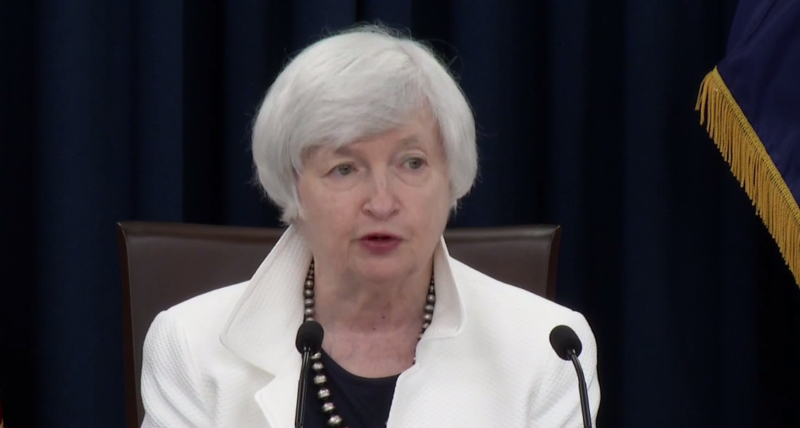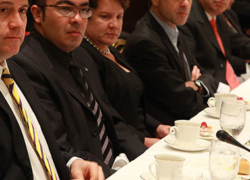Latin America Advisor
A Daily Publication of The Dialogue
How Are U.S. Fed Decisions Affecting Latin America?
 Chair Janet Yellen announced last week that the Fed would leave interest rates unchanged and would begin unwinding the stimulus it put in place nearly a decade ago.
Chair Janet Yellen announced last week that the Fed would leave interest rates unchanged and would begin unwinding the stimulus it put in place nearly a decade ago.
The U.S. Federal Reserve on Sept. 20 announced its decision to keep interest rates steady and to begin unwinding stimulus it put in place amid the Great Recession. What effect will the Fed’s decision have on emerging markets, specifically in Latin America? How vulnerable are Latin American economies to any future Fed policy changes? What can Latin American economies do to best respond to rising U.S. interest rates in the future?
Alicia Bárcena, executive secretary of the United Nations Economic Commission for Latin America and the Caribbean (ECLAC): "The decision by the U.S. Federal Reserve to leave interest rates unchanged and to start withdrawing quantitative easing (QE) in October had been somewhat expected, so there was not much effect on financial market volatility. There was, however, an immediate effect on the dollar, which appreciated as the Fed signaled that it still expects one more increase of 25 basis points by the end of the year and three more in 2018. Also, the prices of some commodities were negatively affected. Traditionally, Fed policy rate decisions have been transmitted to Latin American countries through several channels. The first is the effect of Fed decisions on general market volatility and uncertainty. For the last couple of years, this has not been such an issue, given the Fed’s relative predictability. The second is the effect on the value of the dollar and hence of Latin American currencies. Rate hikes (or the announcement of future hikes) accompanied by an appreciation of the dollar vis-à-vis Latin currencies can induce portfolio adjustments and therefore affect financing flows to the region. Currency depreciations can also have adverse effects in some Latin American and Caribbean countries that have currency mismatches in public and/or private debt. Even though that average inflation rate is in a downward trend in the region, the depreciation of national currencies can produce increases in domestic inflation rates, inducing central banks in the region to increase interest rates. The possible pass-through of depreciation may reinforce the future upward pressure on domestic interest rates produced by future Fed rate increases. After a long period of exceptionally abundant liquidity and very low interest rates, the increase in the Fed’s rate, together with the unwinding of the QE, will increase the external cost of financing for the region. It is expected that this increase will happen at a slow pace. On the one hand, the Fed is planning to proceed slowly and avoid surprises, and on the other, hand the Bank of England the Bank of Japan and the European Central Bank are all expected to maintain liquidity abundant in the medium turn."
Alfredo Coutiño, director for Latin America at Moody’s Analytics: "The era of cheap money is coming to an end and is a work in progress, particularly with the Fed’s monetary cycle of rate hikes. The Fed’s decision to leave the interest rate unchanged benefits Latin American economies because it eases pressures on domestic policy; any rate hike in the United States that is not followed by a similar hike in Latin America generates a reduction in the rate differential, putting the region’s bond market at a disadvantage. Higher rates also produce higher costs for new debt issued by the region in international markets. Stable rates in the United States provide a benefit in terms of financial costs for governments and corporations in Latin America. Fortunately, the Fed’s monetary tightening is taking place at a gradual pace, letting markets absorb the change smoothly. The same way that Latin America benefited from low rates in the United States, it will be affected by higher rates abroad. Future changes in U.S. rates will impose pressures on Latin American bonds, risk that can be deactivated if central banks match the U.S. rate hikes. Otherwise, Latin American bonds will lose attractiveness, a process that could generate capital outflows. Countries more vulnerable to the U.S. monetary cycle are those with central banks that persistently keep the policy interest rate too low and well below the neutral rate. Countries less vulnerable are those that took preventative measures and normalized monetary conditions. Since higher rates are definitely on the horizon for emerging markets, the best protection that Latin America can have is to continue reducing the main macroeconomic imbalances in terms of fiscal and external accounts, because that will reduce the region’s needs of external financing."
Edwin M. Truman, nonresident senior fellow at the Peterson Institute for International Economics: "The important move made by the Federal Open Market Committee (FOMC) of the Federal Reserve was not its decision against further raising the target range for the federal funds rate, but rather the decision to start reducing the size of its balance sheet. As the Federal Reserve in effect sells long-term assets over the next several years, this will put upward pressure on long-term dollar interest rates at the same time that the target range for the federal funds rate increases by between 150 and 200 basis points, according to FOMC projections. The spread between long and short rates will increase slightly, but will probably be less than 100 basis points. What will this mean for emerging market economies? For most of countries, the effects will be minimal, in part because this process of normalization will be gradual and stretched over several years. However, a few countries are vulnerable because of excessive foreign borrowing by the government or private sector, large current account and/or fiscal deficits, or exchange rate regimes that are too rigid. These countries risk crises without the Federal Reserve’s normalization of U.S. monetary policy. Their leaders would be mistaken to blame the United States or the Federal Reserve for policy problems of their own making. They need to put their respective economic and financial houses in order regardless of the strength of the financial winds coming from the United States."
Wally Swain, senior vice president for emerging markets at 451 Research in Bogotá: "Latin American countries are generally very sensitive to U.S. interest-rate and thus exchange-rate movements (except Panama and Ecuador, which have dollarized economies). All depend on exports of natural resources, most have weak manufacturing sectors, especially for IT-related goods and so depend on imports, and most have high levels of government debt, often denominated in U.S. dollars. These generalizations, as always, hide a rich diversity of special circumstances. On the one side (the right side?) of the ledger are the Pacific Alliance countries (Mexico, Colombia, Peru, Chile) with open economies, prudent finances and flexible exchange rates. On the other (left?) side are countries that try to close off their economies, despite their need for trade and dollar-denominated debt. Venezuela is the most extreme example, but Fed policy has little influence over Venezuela’s out-of-control inflation and exchange rate. However, even the prudent managers of the Pacific Alliance watch the ‘tea leaves’ of the Fed closely. Colombia has received much attention recently for ending its half-century conflict with the FARC, which experts say could boost GDP by one or two percentage points. Unfortunately, the economy is currently in the doldrums, lower oil prices have seriously damaged government finances at all levels and the cost of implementing the peace accords is very high. That puts policymakers in a complex situation. Higher U.S. interest rates would have devalued the Colombian peso, stimulating exports but simultaneously making dollar-denominated debt more expensive. Luckily, the country’s credit rating still holds, and still permits it to place peso-denominated bonds (domestically and externally), insulating Colombia’s debt somewhat from the Fed’s decisions."
Lourdes Casanova, senior lecturer and director at the Johnson Emerging Markets Institute at Cornell University: "Normally the situation would have affected Latin America negatively, for a number of reasons. For one, the Brazilian stock market last year and the Mexican stock market this year had record profits. Usually when you see the U.S. dollar strengthen, money managers will decide to go back to a safer area—that is always the dollar—and cash the profits from the local stock markets. However, some interesting things have happened. The United States does not seem interested in a very strong dollar, so we don’t know if the dollar will strengthen that much. Also, Mexico is facing a unique issue that came up after President Trump was elected. We don’t know what will happen with the Fed in the future, though of course at some point we will have to move back to ‘normal’ territory. Though how quickly the Fed will raise rates, and by how much, is not clear. And lastly, Janet Yellen will reach the end of her term in February 2018. Who will replace her? What will be the policies of the next Fed chair? President Trump has said a number of times that he wants the next Fed chair to be more in line with the government’s policies. So we will have to see if this year’s murmurings of raising the rate end up being much ado about nothing."
The Latin America Advisor features Q&A from leaders in politics, economics, and finance every business day. It is available to members of the Dialogue's Corporate Program and others by subscription.



















